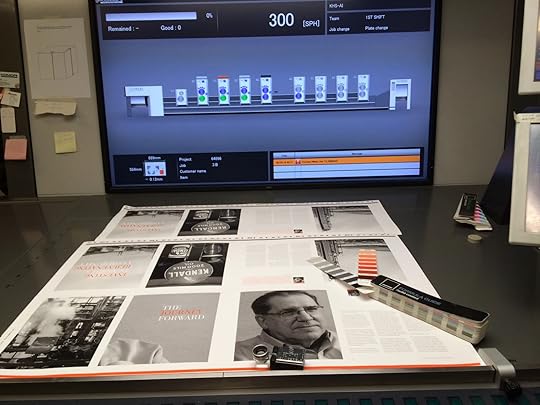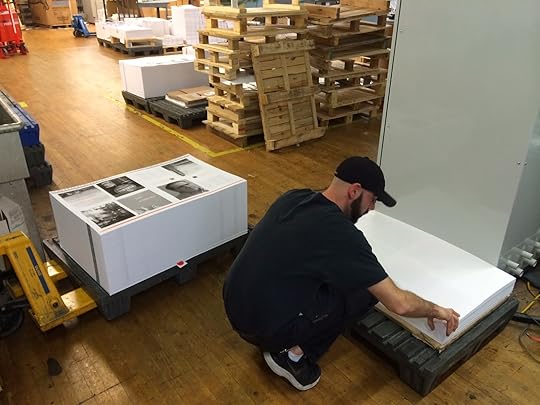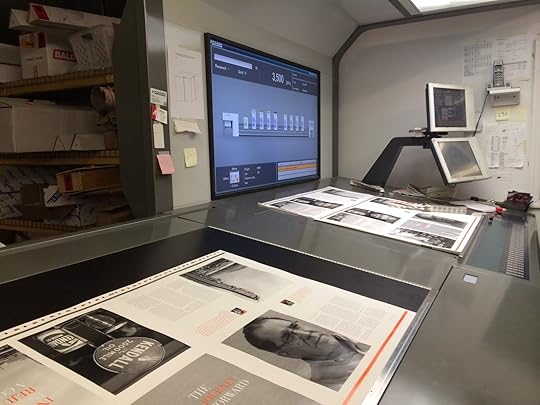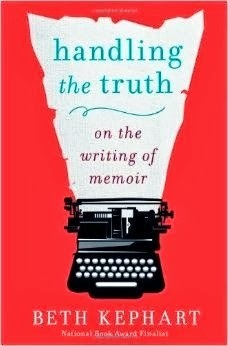Beth Kephart's Blog, page 95
March 6, 2014
(wardrobe choices) Books for a Better Life, Converse College, Texas Library Association: here I come
 I'm not a talented shopper. I'm best off in a don't-think-about-it pair of jeans (just ask my students, who have seen me in nothing but).
I'm not a talented shopper. I'm best off in a don't-think-about-it pair of jeans (just ask my students, who have seen me in nothing but).But three very exciting things are afoot—the Books for a Better Life Awards program, this coming Monday in New York City (Meredith Vieira! Arianna Huffington, Handling the Truth!); a series of talks as the Elizabeth Boatwright Coker Visiting Writer at Converse College, South Carolina, next Tuesday and Wednesday (Susan Tekulve! my SC friends!); and the Texas Library Association meeting on April 10 and 11 (San Antonio, TX! Chronicle friends!, fellow authors).
And so I had to go to the store.
This is painful for me, people. Painful. Mirrors are not my friend.
But here we go. Bright pink to ward off the winter blues. A little fluff in the skirt to approximate a spring breeze. And a pair of nude pumps because I've never owned a pair before and because everyone who helped me today (when I said I didn't own a pair of nude shoes) looked at me as if they wanted to ask, And are you a woman?
Yes, I am. Thank you very much. And now I own a pair of nude pumps.




Published on March 06, 2014 10:31
Seeing our book project through, at Epic Litho


 We left the house at the 7 AM hour to attend a press check at Epic Litho. Around here, at Fusion Communications, press checks are our Christmas times. They are our Santa Claus. They're what we work for.
We left the house at the 7 AM hour to attend a press check at Epic Litho. Around here, at Fusion Communications, press checks are our Christmas times. They are our Santa Claus. They're what we work for.The project on the press was a book created to tell the story of the extraordinary "refinery that could" (American Refining Group). Of the man—Harry Halloran, Jr.—who, in buying the once-endangered plant for a dollar (and the promise of considerable other investments), saved the jobs of employees and strengthened the surrounding community. Of the people who were trusted to lead. Of management's great respect for the environment. Of the town itself that has rallied, in recent years, thanks to committed educational, cultural, and health care visionaries.
I had the pleasure of researching and writing this book. My husband took the exquisite photography and designed the book with his trademark care. The company's leadership and administrative team (including Harry, of course) were there at every turn to help us bring the story to life.
To print and bind this cloth-bound project, we turned to an old friend, Jarred Garber, with whom we have worked for many years. Jarred is the senior account manager at Epic Litho in Phoenixville, PA. He and has team have delivered—time and again—stellar projects. They are not just knowledgeable and personable; they work with some of the best equipment around, all in a building, by the way, that once housed a roller skating arena. These people know their stuff. They're trusted by clients ranging from Godiva, Ferrari, and Dansko to Bucknell University to Dunwoody Village to the little communications company that also can, Fusion Communications.
When it's press check time, they open their doors and let the eager writer/designer in.
A post, then, to thank Harry Halloran, Jr. and his entire team. A post to thank Jarred and Epic Litho for taking such great care of us.




Published on March 06, 2014 07:31
March 4, 2014
what is your memoir about? my students provide shining examples
 Life: It gets all tangled up. Those of us who want to write about it have to separate the skeins.
Life: It gets all tangled up. Those of us who want to write about it have to separate the skeins.The students of English 135.302 (University of Pennsylvania) are now hard at work on their memoirs, and I cannot wait to read them. While I wait, I look back and honor the work of my former students—excerpted in Handling the Truth.
Speaking of former students—Daniel Blas, whose fine memoir was adapted for the Pennsylvania Gazette last year—will be returning to class today to speak with Trey Popp, one of the Gazette editors, about the process. If you didn't get a chance to read Dan's work the first time around, here's your chance.
Now from Handling the Truth:
<!-- </style><br />--> <style><!-- /* Font Definitions */ @font-face {font-family:Cambria; panose-1:2 4 5 3 5 4 6 3 2 4; mso-font-charset:0; mso-generic-font-family:auto; mso-font-pitch:variable; mso-font-signature:3 0 0 0 1 0;} @font-face {font-family:SimSun; mso-font-alt:宋体; mso-font-charset:134; mso-generic-font-family:auto; mso-font-pitch:variable; mso-font-signature:3 135135232 16 0 262145 0;} @font-face {font-family:Mangal; mso-font-charset:0; mso-generic-font-family:auto; mso-font-pitch:variable; mso-font-signature:32771 0 0 0 1 0;} /* Style Definitions */ p.MsoNormal, li.MsoNormal, div.MsoNormal {mso-style-parent:""; margin:0in; margin-bottom:.0001pt; mso-pagination:widow-orphan; font-size:10.0pt; font-family:"Times New Roman"; mso-fareast-font-family:"Times New Roman"; mso-bidi-font-family:"Times New Roman";} p.MsoCommentText, li.MsoCommentText, div.MsoCommentText {mso-style-link:"Comment Text Char"; margin:0in; margin-bottom:.0001pt; mso-pagination:none; mso-hyphenate:none; font-size:12.0pt; font-family:Mangal; mso-ascii-font-family:"Times New Roman"; mso-fareast-font-family:SimSun; mso-hansi-font-family:"Times New Roman"; mso-bidi-font-family:Mangal; mso-font-kerning:.5pt; mso-ansi-language:X-NONE; mso-fareast-language:HI;} span.MsoCommentReference {mso-style-noshow:yes; mso-ansi-font-size:8.0pt; mso-bidi-font-size:8.0pt;} p.MsoEndnoteText, li.MsoEndnoteText, div.MsoEndnoteText {mso-style-noshow:yes; margin:0in; margin-bottom:.0001pt; mso-pagination:widow-orphan; font-size:12.0pt; font-family:"Times New Roman"; mso-fareast-font-family:"Times New Roman"; mso-bidi-font-family:"Times New Roman";} span.EndnoteTextChar {mso-style-name:"Endnote Text Char"; mso-style-noshow:yes; mso-style-locked:yes; mso-style-link:"Endnote Text"; mso-ansi-font-size:12.0pt; mso-bidi-font-size:12.0pt; font-family:"Times New Roman"; mso-ascii-font-family:"Times New Roman"; mso-hansi-font-family:"Times New Roman";} span.CommentTextChar {mso-style-name:"Comment Text Char"; mso-style-locked:yes; mso-style-link:"Comment Text"; mso-ansi-font-size:12.0pt; mso-bidi-font-size:12.0pt; font-family:"Times New Roman"; mso-ascii-font-family:"Times New Roman"; mso-fareast-font-family:SimSun; mso-hansi-font-family:"Times New Roman"; mso-bidi-font-family:Mangal; mso-font-kerning:.5pt; mso-ansi-language:X-NONE; mso-fareast-language:HI;} p.04BodyText, li.04BodyText, div.04BodyText {mso-style-name:"04 Body Text"; mso-style-parent:""; mso-style-link:"04 Body Text Char"; margin:0in; margin-bottom:.0001pt; text-align:justify; text-indent:22.0pt; line-height:200%; mso-pagination:none; font-size:11.0pt; mso-bidi-font-size:12.0pt; font-family:"Times New Roman"; mso-ascii-font-family:Cambria; mso-fareast-font-family:"Times New Roman"; mso-hansi-font-family:Cambria; mso-bidi-font-family:"Times New Roman"; mso-font-kerning:11.0pt;} p.06Extract1P, li.06Extract1P, div.06Extract1P {mso-style-name:"06 Extract 1P"; mso-style-next:"04 Body Text"; margin-top:14.0pt; margin-right:22.0pt; margin-bottom:14.0pt; margin-left:22.0pt; text-align:justify; line-height:200%; mso-pagination:none; font-size:11.0pt; mso-bidi-font-size:12.0pt; font-family:"Times New Roman"; mso-ascii-font-family:Cambria; mso-fareast-font-family:"Times New Roman"; mso-hansi-font-family:Cambria; mso-bidi-font-family:"Times New Roman"; mso-font-kerning:11.0pt;} span.04BodyTextChar {mso-style-name:"04 Body Text Char"; mso-style-locked:yes; mso-style-parent:""; mso-style-link:"04 Body Text"; mso-ansi-font-size:11.0pt; mso-bidi-font-size:12.0pt; mso-font-kerning:11.0pt;} @page Section1 {size:8.5in 11.0in; margin:1.0in 1.25in 1.0in 1.25in; mso-header-margin:.5in; mso-footer-margin:.5in; mso-paper-source:0;} div.Section1 {page:Section1;} </style> --> <blockquote class="tr_bq"><div class="04BodyText">Sometimes you can get at [the life questions] obliquely, through structure and white space. Sometimes you do it by rubbing the now against the then. Sometimes we accentuate the terrible discrepancy. Sometimes we are writing toward forgiveness—of ourselves, of others. This is the beauty of memoir. If all your memoir does is deliver story—no sediments, no tidewater, no ambiguity—we have no reason to return. If you cannot embrace the messy tug of yourself, the inescapable contradictions, the ugly and the lovely, then you are not ready yet. If you can’t make room for a reader, then please don’t expect a reader to start making room for you.</div><div class="04BodyText"><br /></div><div class="04BodyText">Kim, my dark-haired student with the Cleopatra eyes, chose to write her memoir about luckiness, unluckiness, and love. My favorite paragraph:</div><div class="04BodyText"><br /></div><blockquote class="tr_bq"><div class="06Extract1P">Love makes you dependent; pain pushes you to the breaking point of self-actualization. My parents’ support and the stability they provided for me is something I’m still trying to justify by replacing their hands with my own, finger by finger. Every day I lift a barricade to get through hermitage and extroversion, harmony and entropy, my mother’s love and my mother’s illness, innovation and inundation. I was lucky, I was born an American, I was born healthy, I was born into a loving home. I was unlucky, I was born judgmental, I have seen terror, I have seen desperate cries for life. So we continue: surprised, derisive, and awake by intuition.</div></blockquote><div class="06Extract1P"><br /></div><div class="04BodyText">Jonathan wrote about prayer as hobby, and about religious fanaticism:</div><div class="04BodyText"><br /></div><blockquote class="tr_bq"><div class="06Extract1P">Prayer was my new hobby, easily eating up an hour of every morning. My religious observance became systematic: I had to make sure experimental conditions were optimal. Experiments fail if they aren’t perfectly calibrated—perhaps my prayer was similarly ineffective because I was ignoring some ritualistic detail. Scientific precision was giving way to religious fanaticism. I was too skeptical of reality to reject superstition so quickly—and I had so much to lose. For two years, I was blinded by minutiae. Then I found academic biblical analysis.</div></blockquote><div class="06Extract1P"><br /></div><div class="04BodyText">Gabe wrote about surviving a heart condition; more than that, though, he wrote to imagine what a son’s illness means to a mother:</div><div class="04BodyText"><br /></div><blockquote class="tr_bq"><div class="06Extract1P">This was also probably what she begged for when, after I had gone unconscious in the hospital that day in February, the doctor spoke with her and told her that her son was very sick and that every effort was being made to save him. She had flown to Peru the night before to be with her father who was on his deathbed. She must have hung up the phone, heard the echo of the handset hitting the cradle resounding in her head, and felt her knees buckling beneath her. She somehow gathered strength, said what she thought was a last goodbye to her dying father, and boarded a plane towards Philadelphia. Those eight hours of flight must have been claustrophobically helpless. No jet plane could have flown fast enough to make this trip bearably short. No altitude could have brought her close enough to God so that she could scream loud enough in his ear to please save her son.</div></blockquote><div class="06Extract1P"><br /></div><div class="06Extract1P"><br /></div><div class="04BodyText">Responsibility—to one’s self and to others—was the theme that engaged Stephanie.</div><div class="04BodyText"><br /></div><blockquote class="tr_bq"><div class="06Extract1P">How much of your life, the life you know, is actually your own? We all do things for others, stretching out limbs like a thigmotropic plant clinging to the structure of another to both give and receive life-sustaining supplements. But what do we do for ourselves that we do not do for others? What moments are we robbed of, what people do we give too much to? And when, if ever, are we truly independent?</div></blockquote><div class="06Extract1P"><br /></div><div class="04BodyText">No one can or should tell you what to write about. But if you don’t know where the memoir impulse is coming from, if you can’t trace it, can’t defend it, can’t articulate an answer when somebody asks “Why’d you want to write a memoir anyway?”—stop. Hold those memoir horses. Either the mind has been teased for years upon years, or there’s that small thing that won’t be refused, or there’s something else genuine and worthy. But nobody wants to hear that you’re writing memoir because you need some quick cash, or because you think it will make you famous, or because your boyfriend said there’s a movie in this, or because you’re just so mad and it’s about time you get to tell your version.</div></blockquote><br /><div style="mso-element: comment-list;"><hr align="left" class="msocomoff" size="1" width="33%" /><div style="mso-element: comment;"><div class="msocomtxt" id="_com_1"><span style="mso-comment-author: "Susan Barnes";"><a href="https://www.blogger.com/null" name="_msocom_1"></a></span></div></div></div><div class="feedflare">
<a href="http://feeds.feedburner.com/~ff/BethK... src="http://feeds.feedburner.com/~ff/BethK..." border="0"></img></a> <a href="http://feeds.feedburner.com/~ff/BethK... src="http://feeds.feedburner.com/~ff/BethK..." border="0"></img></a> <a href="http://feeds.feedburner.com/~ff/BethK... src="http://feeds.feedburner.com/~ff/BethK..." border="0"></img></a> <a href="http://feeds.feedburner.com/~ff/BethK... src="http://feeds.feedburner.com/~ff/BethK..." border="0"></img></a>
</div>
Published on March 04, 2014 05:12
March 3, 2014
we need each other
 I wrote of the calculated inwardness of this long winter to a friend earlier today. He understood. I wrote of the defeat of grey, of my fear, during this oppositional season, that I had let friendships lull—that it had become so hard, so cold, so iced over out there that I had finally succumbed.
I wrote of the calculated inwardness of this long winter to a friend earlier today. He understood. I wrote of the defeat of grey, of my fear, during this oppositional season, that I had let friendships lull—that it had become so hard, so cold, so iced over out there that I had finally succumbed.But it is almost spring.
Today I wished to restore things. Today I wrote to friends with whom the correspondence has stilled. Today I read Michael Ondaatje, trusting. Today I allowed myself an hour of not making something, explaining something, fearing something, wanting something.
These things happened: A beloved neighbor knocked on the door and came in. A former student wrote of her memories of our time together last spring. A dear writer friend wrote to say that she was reading something of mine at an airport, while waiting, no place more private than an airline terminal. My son wrote to me, gigantically. A note came in—handwritten, red. Another note—electronic ink. A card signed in blue. A thank you. Old friends became unlost friends. I lifted my head and said, Hey.
Hey.
It's almost spring.
We need each other.




Published on March 03, 2014 14:49
Music Monday: Elton John at the Berlin Wall
Sorry. I can't resist. I'm going to be sharing these Berlin Wall-inspired songs by sometimes expected, sometimes unexpected classic artists every Monday as we move toward the launch (less than a month away!) of Going Over. This is Elton John singing "Nikita," a song (with a somewhat controversial history) that appeared on his 1985 album Ice on Fire. John says that he did know that Nikita is a man's name in the Russian language, even though the love object depicted here is a beautiful blonde East German border guard.




Published on March 03, 2014 07:36
March 2, 2014
how I know I'm home
 Yesterday I set off to the local Whole Foods around 5 PM. I'd been sitting most of the day, working, and I wanted the air. Some of the neighbors were out, defying news of the coming storm. Like a summer holiday, I thought, only we all had our winter coats on.
Yesterday I set off to the local Whole Foods around 5 PM. I'd been sitting most of the day, working, and I wanted the air. Some of the neighbors were out, defying news of the coming storm. Like a summer holiday, I thought, only we all had our winter coats on.I'd only just turned the corner on my street when a father and a son invited me up to their garage to see a project that has occupied them for the past four years. This something bright and red they've building. This piece of history, restored. "Hey, Sweetheart," they called to me, as I was walking by. "Have a minute?"
I always have a minute for these two men who are, in so many ways, the pillars here. In addition to their day jobs, they keep this place whole—mowing lawns, collecting leaves, fixing cars, plowing snow, unsticking doors that get stuck. I've watched the son grow up. I've watched the father never grow old. "Hey, Sweetheart," they call. "You need a ride, Sweetie?" "Your house weathering the snow?" "Anything you need, you holler."
They are the irreplaceables—this father and son. They are how I know I'm home—that I picked the right corner of this town to raise my son, to grow up and old. "Sweetheart," they say, "let us know what you need." "Sweetheart, we'll be here if you call."
I snapped this photograph on my way back from the store. Still a little pink in the sky, still a little hope that the forecast of another storm will be a weather anchor's lie. But if the snow comes as they say the snow will come, I know where the lights will still burn.




Published on March 02, 2014 06:28
March 1, 2014
The Picture that Remains: Will Brown (photography) and Thomas Devaney (poems), produced by The Print Center
 I receive an extraordinary number of books and manuscripts here at my tiny house, and I struggle to keep up. Inevitably I disappoint more people than I make happy. I always feel lousy about that.
I receive an extraordinary number of books and manuscripts here at my tiny house, and I struggle to keep up. Inevitably I disappoint more people than I make happy. I always feel lousy about that.But earlier this week, when a PDF of The Picture that Remains appeared in my in-box, I stopped. I could tell at a glance that this project—a collaboration between the photographer Will Brown and the poet Thomas Devaney—was the product of something genuinely artful, and good. I could see, too, that its publisher, the esteemed The Print Center (its mission: "to support printmaking and photography as vital contemporary arts and encourage the appreciation of the printed image in all its forms") had cared enormously throughout its making of this glorious object. The typography, the duo-ing, the quiet space, the photographic shine are exquisite singularly and combined.
And then there is the introduction by Vincent Katz, which doesn't just tell the story of this particular adhesion of old photographs and new words, but tells as well the history of artistic collaboration, touching on Manet's and Mallarme's shared conversation about Poe, the cohering spirit of Black Mountain College, and the some-of-this and some-of-that conducted by the poet/critic Edwin Denby and the photographer/filmmaker Rudy Burckhardt. Katz's introduction is an education.
The pages that follow are an education, too—in the old streets of Philadelphia's Queen Village, in the shops that had closed for good, in the cars we presume to be abandoned, in the stories inscribed inside an old hutch, in the clothes that are hung in a window. Brown's photographs fill me with the longing that I experience every time I look at a Walker Evans photograph. They say, simply, This was.
Devaney, who once taught at Penn and now teaches poetry at Haverford College, is well known for his intriguing collaborative endeavors; he has consistently found a way in to seemingly closed things and pulled the shutters back. Here, in The Picture that Remains, Devaney nests his images in the in-between of what the photographs say and how the mind interpolates. He suggests what was. He fictionalizes for the sake of learning something true.
About that corner hutch, for example, Devaney writes:
A sack of purple potatoes fueling a clock.
Some trickle, some stream in the black
walnuts stain—its current current:
three quarts of hulls, one quart rain water.
Who could not love a project like this? Who would not commend Elizabeth Spungen, the executive director of The Print Center, for encouraging this collaboration, for overseeing the making of the book, and for ensuring that photographs that had been locked away are seen again—and percolated by Devaney's words. Listen to Spungen, who writes this in the end, and you'll be listening to the sound of real art, still in the making:
And so all the pieces have come together, and we have succeeded in bringing these magnificent photographs out of the boxes which safeguarded them for thirty years. It is both ironic and fitting that the images that Brown captured so many years ago prefigured what his pictures would become—a paean to a time and moment long passed.Copies of the book are available from The Print Center, located at 1614 Latimer Street. They can also be purchased online.




Published on March 01, 2014 12:04
The Art of Faith: Talking Philadelphia and Memoir this weekend, at St. David's Episcopal Church
 This weekend, St. David's Episcopal Church in Radnor, PA, is celebrating the life of St. David, Patron Saint of Wales, who established the church (a glorious stone building about a mile from my home) three hundreds years ago. Photography, singing vicars, and literature are all part of the fare, and I'm honored to be included.
This weekend, St. David's Episcopal Church in Radnor, PA, is celebrating the life of St. David, Patron Saint of Wales, who established the church (a glorious stone building about a mile from my home) three hundreds years ago. Photography, singing vicars, and literature are all part of the fare, and I'm honored to be included.My own talk is a two-part talk. First up—a Handling the Truth memoir workshop, in which participants will have a chance to learn about truth and consequences, sentences and ideas. Following a short break, I'll be discussing 19th century Philadelphia, particularly my three Philadelphia books—Flow, Dangerous Neighbors, and Dr. Radway's Sarsaparilla Resolvent. There will be workshops here as well—fun exercises designed to get us thinking about our city more than a century ago.
These events are free and open to the public. The photography exhibit runs all day today and tomorrow, and includes an 11:00 AM photography symposium moderated by Tom Petro tomorrow.
My event is being held on Sunday in the Choir Room, Chapel, Lower Level. We'll start at 1:30 and go through 4:00 PM. Stay for both sessions, or come just for one. Teens and adults are both welcome (and, indeed, encouraged).




Published on March 01, 2014 04:25
February 28, 2014
Junior Library Guild and The Flyleaf Review: A banner GOING OVER day
 Oh, I said, earlier today, in the shivery cold. Look! A package from Chronicle Books.
Oh, I said, earlier today, in the shivery cold. Look! A package from Chronicle Books. What is it? my husband asked.
Don't know, I said. And then, within minutes, I did—a beautiful note, indeed a gold-seal note, from Junior Library Guild, noting the selection of Going Over for this great honor.
I had no idea there was a gift beyond the gift of being selected. I was truly stunned.
And then, over at Twitterland, that gorgeous Heather R. of The Flyleaf Review started sending me sly little winks. What is that girl talking about, I wondered (while I was supposed to be doing my day job)? I clicked and took a look — and — well — wow.
What a review of Going Over that gracious woman wrote. What a review, and, Heather says, this is just a tease, in advance of the Going Over blog tour. A tease that includes one of the most incredible photographs I've ever seen of lovers at the Berlin Wall.
There's your Ada and your Stefan, Heather said. And yeah. Absolutely. That's them.
(Tears, actual tears, fell.)
Please go on over and check out the link. I don't want to summarize, I don't want to give you any excuse not to experience The Flyleaf Review—and those lovers—for yourself.
I'm so lucky out here.




Published on February 28, 2014 13:06
The Internet Review of Handling the Truth
 Sarah Morgan gives me the gift this morning of a truly magnificent review of Handling the Truth, now posted here on The Internet Review of Books, a site I was having so much fun reading (the reviews here are of the most interesting books) that I almost forgot to finish this post.
Sarah Morgan gives me the gift this morning of a truly magnificent review of Handling the Truth, now posted here on The Internet Review of Books, a site I was having so much fun reading (the reviews here are of the most interesting books) that I almost forgot to finish this post.But I do wish to finish this post, because I am so very grateful for Sarah's time and for her insights. Her review begins like this, but the whole is well worth the read.
Thank you, Sarah.
There are thousands of books on the subject of writing, and many of those are about memoir. In my mind, only a few stand shoulders above the rest. Handling the Truth: On the Writing of Memoir by Beth Kephart is one of these and a fine addition to any aspiring memoirist’s reference library.
Kephart describes herself as a dreamer and a writer. She worked her way through the writing school of hard knocks, and now, somewhat surprisingly in her mind because of her informal training, she teaches memoir at The University of Pennsylvania. She is also the author of 16 books, five of them memoirs.




Published on February 28, 2014 05:46



